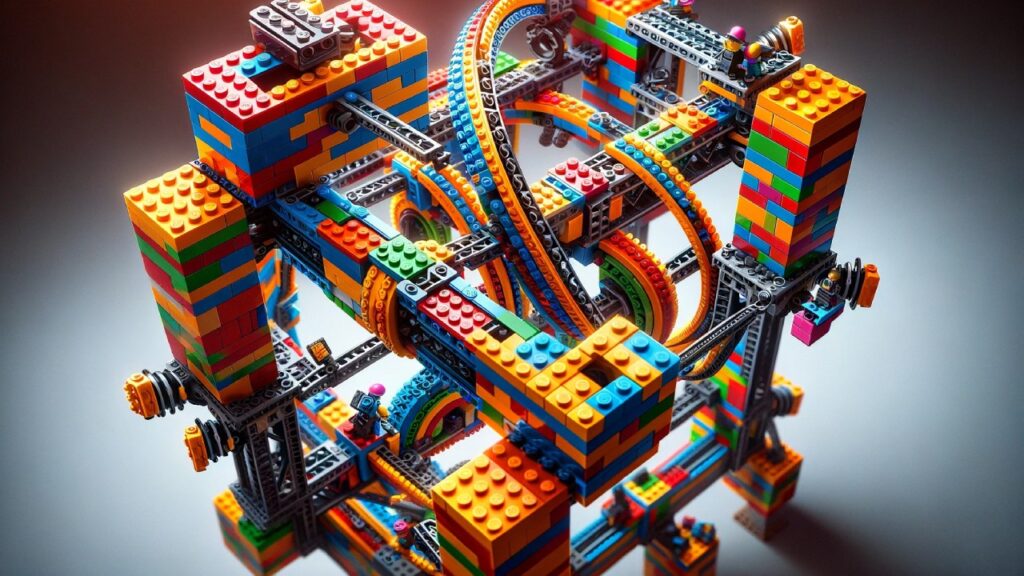Illegal LEGO techniques will have you breaking the mould in more than one way. While some will go a long way at enhancing your LEGO MOCs, quite a few of them are going to put the longevity of your bricks at risk.
Illegal LEGO techniques you should avoid
Sideways Brick Stacking
Stacking bricks sideways or at non-standard angles is not intended by their design.
Over-Stressing Bricks
Bending or twisting pieces in ways that stress the plastic.
Cutting or Modifying Bricks
Physically altering LEGO bricks by cutting, drilling, or reshaping.
Brick Sandwiching
Forcing a tile or brick between the studs of two other bricks, causing pressure.
Half-Stud Offset
Using methods to offset bricks by half a stud, leads to alignment and structural issues.
Improper Connections
Connecting bricks in ways that aren’t mechanically sound or intended, like attaching a brick sideways to a baseplate.
Overlapping Plates
Overlapping plates without a complete stud-and-tube connection.
Forced Tube and Stud Mismatch
Connecting studs and tubes that don’t match in size or shape.
Clipping Bricks to Flex Tubes
Clipping bricks directly onto flexible tubes or hoses.
Tension-Based Connections
Using the flexibility of LEGO bricks to create tension or compression connections.
Non-Standard Angles
Creating angles that aren’t naturally supported by LEGO’s standard geometry.
Unintended Element Usage
For example, using a minifigure hand to grip the side of a tile.
Excessive Brick Jamming
Forcing bricks together in a way that they become extremely difficult to separate.
Gravity-Dependent Structures
Building structures where bricks are held together primarily by gravity or in unsupported ways.
Unsupported Overhangs
Extending bricks or plates beyond a supported base, risking breakage.
Inserting Non-LEGO Objects
Using non-LEGO items to connect or support LEGO structures.
Unusual Rod and Hole Combinations
Inserting rods into spaces not designed for them, like minifigure hands or brick undersides.
Interlocking Adjacent Plates
Interlocking plates by offsetting them in a manner that causes tension.
Brick Wedging
Forcing a brick into a space slightly too small for it, causing stress on surrounding pieces.
Using Bricks as Bending Elements
Bending elements like plates or thin bricks in an arc.
Flexing Baseplates
Bending baseplates to create hills or uneven terrain, which can lead to damage.
Misaligning Joints
Intentionally misaligning Technic pins and holes to create unusual angles or connections.
What are the rules of LEGO?
If you’re planning to create a legitimate MOC, or you’re planning to submit a LEGO Ideas build to the company – you’re going to need to pay close attention to how these rules play out.
Standard Connections
Bricks should be connected using their studs and tubes in standard ways that ensure stability and compatibility with other pieces. This means avoiding techniques that stress the bricks or are not mechanically sound.
Maintaining Structural Integrity
Builds should be structurally sound. This involves using appropriate techniques and bricks to ensure that creations are sturdy and can withstand handling without collapsing.
Following Set Instructions (for Official Sets)
When building official LEGO sets, following the provided instructions is recommended to achieve the intended design. This is especially important for beginners or those looking to recreate the specific model designed by LEGO.
Plates are not allowed between studs
One of the illegal building techniques listed above covers this in-depth, though you’re strictly not allowed to place thin plates between the ridges of studs. They are not secured in place by the proper Systems in Play.
No Modification of Bricks
Modifying LEGO bricks by cutting, drilling, painting, or glueing is generally discouraged, especially in the purist LEGO building community.
Using LEGO-Approved Parts Only
For purists, only official LEGO parts should be used in builds. This excludes third-party or custom pieces.
No Permanent Changes
LEGO building is about the ability to build, unbuild, and rebuild. Permanent changes like glueing pieces together are generally against the spirit of LEGO building.
Technic Pins need full Insertion
You’re not allowed to put Technic pins into Technic bricks without them clicking into place. This allows the pin to flare without putting pressure onto the inside of the brick, and it locks it into place properly.
Amaar began Bricka after a lifelong passion for LEGO.
His time building and collecting LEGO has influenced every aspect of his life, and he’s not stopped creating since.
Having played too many games growing up, Amaar is also a writer for Videogamer, where he reviews hardware and talks about handheld consoles.
When he’s not writing about nerdy things, he’s drawing graphic novels and tattooing at his Manchester studio.

